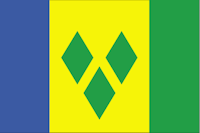Saint Vincent - People
 The U.S. government estimates the total population at 103,000 (July 2015 estimate). Most Vincentians are the descendants of African slaves brought to the island to work on plantations. There also are a few white descendants of English colonists, as well as some East Indians, Carib Indians, and a sizable minority of mixed race.
The U.S. government estimates the total population at 103,000 (July 2015 estimate). Most Vincentians are the descendants of African slaves brought to the island to work on plantations. There also are a few white descendants of English colonists, as well as some East Indians, Carib Indians, and a sizable minority of mixed race.
The country's official language is English, but a French patois may be heard on some of the Grenadine Islands. Linguistic and religious traditions stemmed primarily from the legacy left by two centuries of British rule over the country. Although French patois could be heard on some of the Grenadine Islands, the country's official language was English.
The majority of people were Christian, and 47 percent of the church-going population attended the Church of England. Additional denominations represented included Methodist (28 percent) and Roman Catholic (13 percent). The remainder of the population were Seventh- Day Adventists, Baptists, or Hindus.
Christian prayers are recited at school assemblies; however, attendance and participation are not mandatory. Students wishing to opt out of Christian prayer or religious education classes are excused from participation. Representatives from different religious groups, especially Anglican and Catholic, are occasionally invited to speak to students. Teachers provide information on other religious groups.
A small, unorganized Rastafarian sect also existed in the country; however, Rastafarianism was not a dominant factor in the society. The law prohibits the use of marijuana, including for religious purposes. According to the Caribbean Rastafari Organization, Rastafarians continued to disagree with the government’s prohibition of marijuana use, which they described as integral to their religious rituals. Rastafarians stated they faced scrutiny from police and immigration officials. They also expressed concern about discrimination in schools.
If the "mixed" population, which is primarily African mixed, is added to the officially census designated population of "African/ Negro/ Black", 94 percent of the population of St. Vincent is of African origin. SVG had an indigenous population of Arawaks and Caribs. "Black Caribs", to be distinguished from pure or "Yellow Caribs", issued from intermarriage with the African population. Today the Carib population of St. Vincent is almost all Black Carib. The East Indian population in St. Vincent (1,477) is comprised of two groups -- descendants of indentured labourers from India who arrived in the post-emancipation period (Laurence, 1971), and the newer immigrants (post-1980) from Guyana, Trinidad and India. The older group, although racially distinct, is culturally creole, and there has been significant intermarriage with persons of African origin.
In 2001 the population of Saint Vincent and the Grenadines was 102,631. In 2006, the estimated population was 100,271 and in 2009, it was 101,016, a decrease of 1,615 (1.6%) with respect to 2001. The sex distribution of the population in 2009 was almost even, with males accounting for 50.5% (50,983) and females for 49.5% (50,033). The population aged 60 and over numbered 9,957 (9.9%) in 2009, while the under–15 population totaled 30,969 (30.6%), yielding a dependency ratio of 61.1 per 100 population. A country poverty assessment survey conducted in 2007–2008 found that 39.2% of the population was urban and 60.8% rural. Life expectancy at birth was 71.4 years in 2000 but fell in subsequent years, and by 2009 was 71.2 years (74.1 for females and 69.8 for males).
Achievements in health during the 2006–2010 period included the installation of a seawater reverse osmosis plant in 2010 to provide potable water to the residents of Bequia, one of the Grenadine islands. An electronic health information system introduced in 2010 now links community health centers to the Health Information Unit within the Ministry of Health, Wellness, and the Environment. In 2008, the Government, with assistance from the Government of Cuba, commenced construction of a modern medical complex in the north of Saint Vincent. The facility, which was still under construction in 2010, will encompass the refurbished 30–bed Georgetown Hospital, a diagnostic unit offering radiography and laboratory services, a renal dialysis unit, surgical theaters, and an outpatient department. One of the Government's major initiatives during the period involved the upgrading of three health centers to polyclinics.

|
NEWSLETTER
|
| Join the GlobalSecurity.org mailing list |
|
|
|

